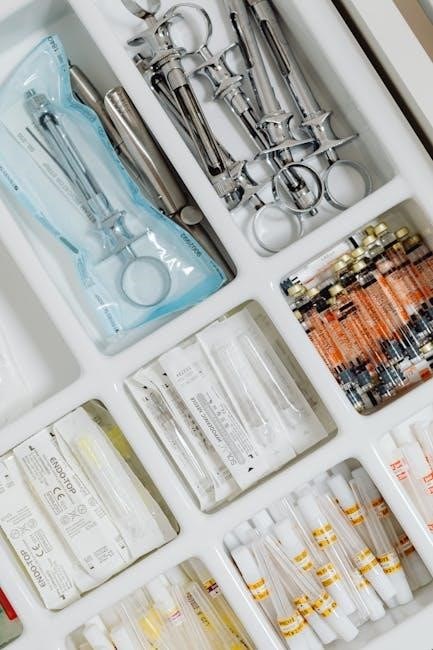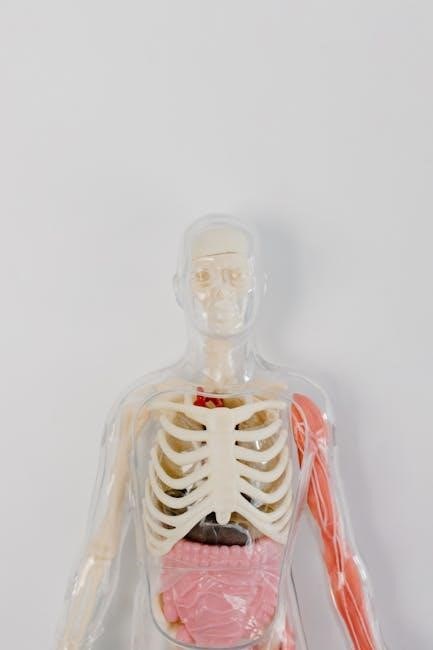Lab values are crucial for diagnosing and monitoring patient conditions. Nurses play a key role in interpreting these values‚ ensuring accurate care. Normal ranges vary by lab and patient factors like age‚ requiring nurses to stay informed and use resources like printable cheat sheets for quick reference.
1.1 Overview of Lab Values and Their Importance
Lab values are essential biological markers used to assess a patient’s health status. They provide critical data for diagnosing conditions‚ monitoring treatment efficacy‚ and detecting potential abnormalities. Nurses rely on these values to identify trends‚ making informed decisions about patient care. Understanding normal ranges and variations is vital‚ as lab results guide interventions and ensure safe‚ effective care. Accurate interpretation of lab values helps nurses prioritize care‚ prevent complications‚ and improve patient outcomes. Staying updated on lab values is a cornerstone of nursing practice‚ enabling nurses to deliver high-quality‚ evidence-based care.

1.2 Role of Nurses in Interpreting Lab Results
Nurses play a vital role in interpreting lab results‚ ensuring accurate and timely patient care. They analyze lab values to identify normal or abnormal findings‚ monitor trends‚ and detect potential issues. Nurses must understand the clinical significance of lab results to prioritize care‚ adjust treatments‚ and educate patients. Their interpretation guides decision-making‚ such as medication adjustments or further testing. Nurses also ensure lab results are communicated effectively to healthcare teams‚ promoting coordinated care. Additionally‚ they use resources like nursing cheat sheets to stay updated on normal ranges and variations‚ enabling them to provide evidence-based care and improve patient outcomes.

Common Blood Tests and Their Normal Ranges
Common blood tests include CBC‚ electrolyte panels‚ and liver function tests. These tests assess overall health‚ detect diseases‚ and monitor treatment effectiveness.
2.1 Complete Blood Count (CBC) and Differential
A CBC measures various blood components‚ including red and white blood cells‚ hemoglobin‚ hematocrit‚ and platelets. The differential identifies the types and percentages of white blood cells‚ aiding in infection detection. Normal ranges vary slightly by lab but typically include RBCs (4.5-5.5 million/μL for men‚ 4.0-5.0 for women)‚ WBCs (4‚500-11‚000/μL)‚ hemoglobin (13.5-17.5 g/dL for men‚ 12-15.5 for women)‚ and platelets (150‚000-450‚000/μL). Abnormal results may indicate anemia‚ infection‚ or bleeding disorders‚ guiding targeted nursing care and patient education.
2.2 Blood Chemistry Tests (Electrolytes‚ Renal‚ Hepatic Panels)
Blood chemistry tests assess organ function and electrolyte balance. Electrolytes include sodium (135-145 mmol/L)‚ potassium (3.5-5.5 mmol/L)‚ chloride (95-110 mmol/L)‚ calcium (8.5-10.5 mg/dL)‚ and magnesium (1.6-2.4 mg/dL). Renal panels measure BUN (8-23 mg/dL) and creatinine (0.6-1.2 mg/dL in men‚ 0.5-1.1 mg/dL in women)‚ indicating kidney function. Hepatic panels include ALT (10-40 U/L)‚ AST (15-40 U/L)‚ and bilirubin (0.3-1.2 mg/dL)‚ reflecting liver health. Nurses use these values to monitor hydration‚ acid-base balance‚ and organ dysfunction‚ guiding interventions like fluid replacement or medication adjustments. Abnormal results may signal conditions requiring urgent care‚ emphasizing the need for accurate interpretation.

Normal Lab Value Ranges for Key Tests
Normal lab values are essential for accurate patient assessment. Key tests include CBC‚ electrolytes‚ and renal panels‚ with ranges varying by age and lab methods.
3.1 Hematology (RBC‚ WBC‚ Hgb‚ Hct‚ Platelets)
Hematology tests measure blood components. RBC (4.5-5.5 million/mcL for men‚ 4.0-5.0 for women) carries oxygen. WBC (4‚500-11‚000/mcL) fights infections. Hgb (13.5-17.5 g/dL for men‚ 12-15.5 for women) and Hct (36-48%) reflect oxygen-carrying capacity. Platelets (150‚000-450‚000/mcL) are crucial for clotting. Nurses monitor these values to detect anemia‚ infection‚ or bleeding risks‚ guiding interventions like transfusions or antibiotics. Variations may indicate chronic conditions or acute issues‚ requiring tailored care plans. Understanding these ranges ensures accurate patient assessments and effective care.
3.2 Electrolytes (Na‚ K‚ Cl‚ Ca‚ Mg)
Electrolytes are essential for maintaining fluid balance‚ nerve function‚ and muscle contractions. Normal ranges include sodium (135-145 mmol/L)‚ potassium (3.5-5.5 mmol/L)‚ chloride (96-106 mmol/L)‚ calcium (8.5-10.5 mg/dL)‚ and magnesium (1.3-2.1 mEq/L). Sodium imbalances can cause hypernatremia or hyponatremia‚ affecting hydration and brain function. Potassium imbalances may lead to cardiac arrhythmias or muscle weakness. Chloride levels reflect acid-base balance. Calcium and magnesium are vital for bone health and neuromuscular function. Nurses must monitor these values to detect imbalances‚ guide fluid replacement‚ and prevent complications like seizures or cardiac arrest.
3.3 Renal Function Tests (BUN‚ Creatinine)

Renal function tests assess kidney health. Blood Urea Nitrogen (BUN) measures waste product levels‚ with normal ranges of 6-24 mg/dL. Creatinine indicates kidney filtration efficiency‚ typically 0.6-1;2 mg/dL for males and 0.5-1.1 mg/dL for females. Elevated BUN may signal dehydration or liver disease‚ while high creatinine suggests impaired kidney function. Nurses monitor these values to identify acute or chronic kidney issues‚ guiding fluid management and medication adjustments. Significant trends warrant further investigation to prevent complications like renal failure. Understanding these tests is crucial for providing targeted care and educating patients on maintaining renal health.
3.4 Hepatic Function Tests (ALT‚ AST‚ Bilirubin)
Hepatic function tests measure liver health. Alanine Aminotransferase (ALT) and Aspartate Aminotransferase (AST) are liver enzymes with normal ranges of 0-40 U/L and 0-45 U/L‚ respectively. Elevated levels indicate liver damage or disease‚ such as hepatitis. Bilirubin‚ a bile pigment‚ has direct (0.1-0.3 mg/dL) and total (0.3-1.2 mg/dL) ranges. High levels suggest liver dysfunction‚ bile duct obstruction‚ or hemolysis. Nurses monitor these values to detect liver issues early‚ guiding treatment and patient care. Understanding these tests aids in identifying conditions like jaundice or cirrhosis‚ ensuring timely interventions and improving patient outcomes. Regular assessment of hepatic function is vital for maintaining liver health and overall well-being.
3.5 Coagulation Studies (PT‚ aPTT‚ INR)
Coagulation studies assess the blood’s clotting ability. Prothrombin Time (PT) measures clotting via the extrinsic pathway‚ with a normal range of 10-14 seconds. Activated Partial Thromboplastin Time (aPTT) measures the intrinsic pathway‚ ranging from 20-35 seconds. International Normalized Ratio (INR) standardizes PT results‚ with a normal range of 0.9-1.2. Elevated PT and aPTT indicate bleeding risks or clotting factor deficiencies‚ while abnormal INR suggests warfarin therapy mismanagement. Nurses monitor these values to adjust anticoagulant dosages‚ preventing thrombosis or bleeding. Accurate interpretation ensures patient safety and effective hemostasis management.

Variations in Normal Lab Ranges
Normal lab ranges differ between laboratories due to varying measurement techniques and reference populations. Age‚ gender‚ and testing methods can also cause variations‚ requiring nurses to consider these factors when interpreting results for accurate patient care.
4.1 Differences Between Laboratories
Normal lab value ranges can vary significantly between laboratories due to differences in testing methods‚ reference populations‚ and equipment. Each lab establishes its own normal ranges based on the specific techniques and instruments used‚ which can lead to discrepancies in results. For example‚ automated analyzers may produce different results compared to manual methods. Additionally‚ some labs may use different units of measurement or reference intervals‚ further complicating comparisons. Nurses must be aware of these variations to avoid misinterpretation of results. It is essential to consult the specific laboratory’s reference ranges when interpreting patient results to ensure accurate clinical decisions and patient care.
4.2 Age-Related Variations in Normal Values
Normal lab values can vary significantly based on a patient’s age. For instance‚ infants and elderly individuals often have different reference ranges compared to adults. Hemoglobin levels in newborns are higher than in adults‚ while creatinine levels in the elderly may be elevated due to reduced renal function. Pediatric reference ranges are particularly nuanced‚ as they account for growth and developmental stages. Nurses must consider these age-related variations when interpreting lab results to ensure accurate clinical decisions. failure to recognize these differences can lead to misinterpretation of normal versus abnormal results‚ potentially affecting patient outcomes. Age-specific reference ranges are essential for proper assessment and care.

Clinical Significance of Lab Values
Lab values guide treatment decisions‚ detect abnormalities‚ and monitor disease progression. Understanding their clinical significance helps nurses identify trends‚ assess patient conditions‚ and provide targeted care effectively.

5.1 When to Suspect Abnormal Lab Results
Identifying abnormal lab results is critical for accurate patient care. Suspect abnormalities when results deviate from normal ranges‚ show significant changes from baseline‚ or don’t align with clinical presentation. Consider symptoms‚ underlying conditions‚ and lab variability. Critical lab values‚ such as severe electrolyte imbalances or coagulation issues‚ require immediate attention. Age-related variations and differences between labs may also signal abnormalities. Always verify results and consult additional tests if needed to ensure accurate interpretation and appropriate interventions.
5.2 Interpreting Trends in Lab Results Over Time
Interpreting trends in lab results over time helps nurses identify patterns‚ monitor progress‚ and evaluate treatment effectiveness. Consistent rises or drops in values may signal underlying issues. For example‚ gradually increasing creatinine levels could indicate renal dysfunction. Trends provide context beyond isolated results‚ aiding in early detection of complications. Nurses should consider baseline values‚ age-related variations‚ and transient factors. Communicating these trends to the healthcare team ensures coordinated care. Patient education on lab trends fosters engagement in their health management. Tracking changes over time enhances clinical decision-making and personalized care plans. Using resources like printable guides helps nurses stay updated on normal ranges and variations‚ ensuring accurate trend interpretation.

Nursing Implications of Lab Results
Lab results guide nursing care‚ aiding in diagnosis‚ treatment planning‚ and patient education‚ ensuring personalized and effective interventions based on individual needs and trends.
6.1 How Lab Results Guide Nursing Care
Lab results are essential for tailoring patient care‚ enabling nurses to make informed decisions; They help identify abnormalities‚ monitor treatment effectiveness‚ and detect potential complications early. By analyzing trends in lab values‚ nurses can adjust medications‚ dietary plans‚ or interventions. For example‚ elevated glucose levels may prompt tighter glycemic control‚ while low hemoglobin levels could indicate the need for iron supplements or further testing. Lab results also guide wound care‚ infection management‚ and fluid balance strategies. This data-driven approach ensures personalized‚ evidence-based care‚ improving patient outcomes and safety. Nurses use lab values to educate patients on lifestyle changes and medication adherence‚ fostering better health management.
6.2 Patient Education Based on Lab Values
Lab values serve as a foundation for patient education‚ enabling nurses to explain health status and treatment goals. Nurses interpret results‚ highlighting normal ranges and potential abnormalities. For instance‚ elevated blood glucose levels may prompt education on diabetes management‚ while high cholesterol levels could lead to discussions on heart-healthy diets. Nurses provide practical advice‚ such as dietary changes or medication adherence‚ based on lab findings. Clear communication helps patients understand their conditions and the importance of lifestyle modifications. Visual aids or printed guides‚ like nursing cheat sheets‚ can reinforce learning; By empowering patients with knowledge‚ nurses promote better health outcomes and encourage proactive participation in care.

Resources for Nurses on Lab Values
Nurses can utilize printable cheat sheets‚ digital tools‚ and apps for quick reference on normal lab values and clinical significance‚ enhancing their decision-making and patient care delivery.
7.1 Printable Nursing Cheat Sheets for Lab Values
Printable nursing cheat sheets provide quick access to normal lab value ranges‚ ensuring nurses can rapidly reference key information. These tools are essential for patient care‚ offering a concise overview of hematology‚ electrolytes‚ renal function‚ and coagulation studies. Nurses can easily print and carry these sheets‚ making them invaluable during shifts. Many resources include both US and SI units‚ catering to diverse clinical settings. These sheets often highlight age-related variations and clinical significance‚ aiding in informed decision-making. They are widely available online as PDFs‚ designed for easy readability and portability. Using these cheat sheets enhances efficiency and accuracy‚ helping nurses deliver optimal care while minimizing errors.
7.2 Digital Tools and Apps for Lab Value Reference
Digital tools and apps provide nurses with instant access to lab value references‚ enhancing clinical decision-making. Apps like “Lab Value Reference” offer comprehensive databases of normal ranges for tests such as CBC‚ electrolytes‚ and coagulation studies. These tools often include features like search functions‚ customizable alerts‚ and offline access‚ making them indispensable in fast-paced healthcare settings. Many apps cater specifically to nursing professionals‚ providing detailed explanations of lab abnormalities and their clinical implications. Regular updates ensure that the information remains current with advancements in medical knowledge. These digital resources are invaluable for nurses‚ enabling quick and accurate interpretation of lab results at the bedside or in the clinic.
Lab values are fundamental in nursing‚ guiding patient care and safety. Nurses must interpret results accurately‚ understand normal ranges‚ and use resources for informed decisions.
8.1 Summary of Key Points
Lab values are essential for accurate patient care‚ guiding nurses in diagnosis‚ treatment‚ and monitoring. Normal ranges vary by lab‚ age‚ and patient factors‚ requiring careful interpretation. Nurses must understand hematology‚ electrolytes‚ renal‚ and hepatic function tests to identify abnormalities. Trend analysis over time aids in clinical decision-making. Lab results inform individualized care plans and patient education. Printable cheat sheets and digital tools serve as valuable resources for quick reference. Staying updated on lab values ensures safe‚ effective nursing practice‚ highlighting the importance of continuous learning and adaptation in healthcare settings.
8.2 Importance of Staying Updated on Lab Values
Staying updated on lab values is crucial for nurses to provide accurate‚ evidence-based care. Lab testing is dynamic‚ with advancements in technology and diagnostic capabilities continually evolving. Normal ranges and reference values may change‚ and new tests are developed‚ making it essential for nurses to adapt. Updated knowledge ensures precise interpretation of results‚ enhancing clinical decision-making and patient safety. Variations in lab procedures and reference ranges across institutions further emphasize the need for current information. By staying informed‚ nurses can deliver optimal care‚ educate patients effectively‚ and integrate the latest guidelines into practice‚ ultimately improving patient outcomes and maintaining high standards of nursing excellence.

No Responses